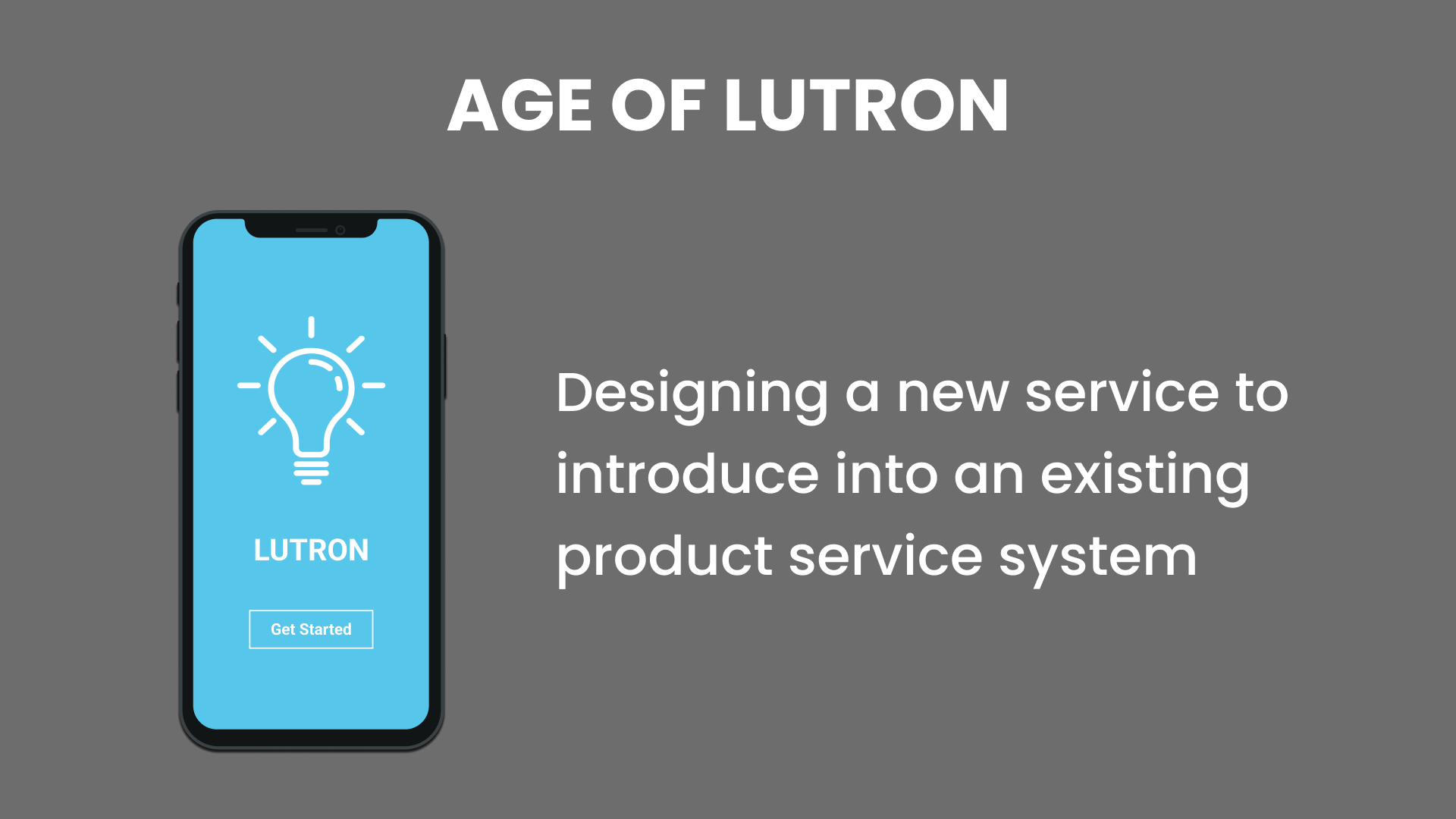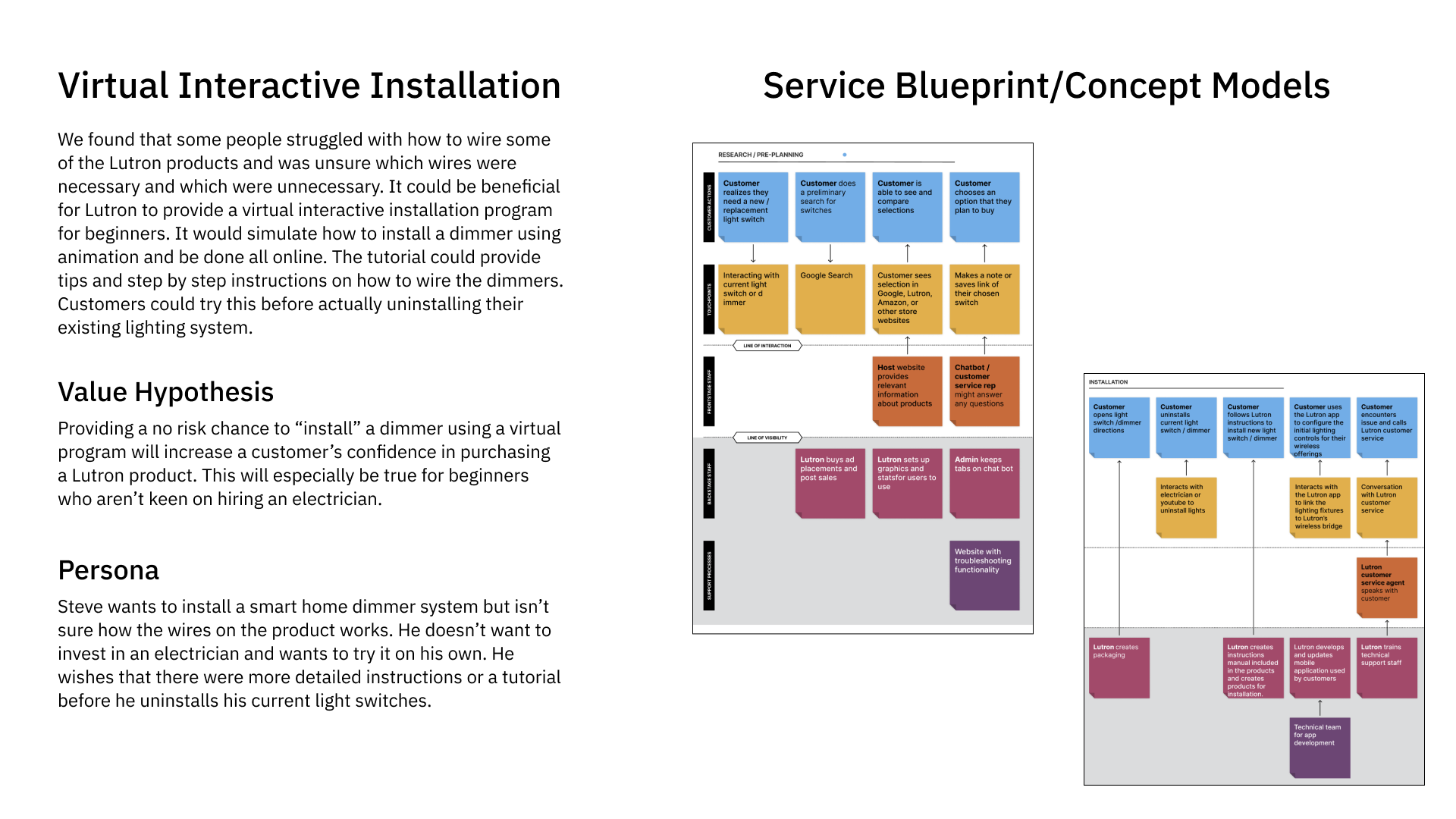
Lutron

How might we improve customers’ installation experience with Lutron products?
Designing a mobile application to improve a product service system.
The Scope
Lutron is an innovative electronics company that focuses on providing its customers with high quality smart dimmers and lighting control solutions. The company operates as a product service system and tasked teams to design a solution that enhances the customer experience within its residential sector. The project was focused on designing a service that would improve the customer-client relationship.
The Project
Client: Lutron (Academic Project)
Team Members: Adhiti Chundur, Luke Arney, Tushar Prakash
Role: UX Researcher & Designer
The Solution
Lutron Digital Installer: A step by step digital installation guide that uses AR technology to help users install Lutron products.
Customers are returning Lutron products due to installation issues, despite the product being marketed as “do it yourself”.

QR Code
Users take an image of QR code located on packaging using their personal device.

Home Recognition
Take an image of your electrical outlet in order to receive a step by step guide.

Installation Guide
Once the application recognizes the user’s home electrical system, the Lutron digital installer will provide instruction within the context of the user’s home.

Moving Next
Instructions remain static on the screen and users can move back and forth between steps. Users may be asked to retake a photo of their updated installation progress in order to receive further instruction.
The Process
Research, User Interviews & Synthesis
Before diving into the interview process, we spent some time gathering secondary data from products reviews. This gave us a better sense of the problems users were having with Lutron products and helped us be more informed as we started the recruiting and interview process. Our team conducted several directed storytelling interviews to better understand how different stakeholder groups interacted within the Lutron service system. I visited Home Depot to interview sales assocaites and discover why a customer might return a Lutron product. I also interviewed customers and installers to get a better sense of the industry and product. From these interviews we were able to identify common pain points and it became evident that customers were struggling with installing their Lutron products. While higher end products require a professional installer, Lutron offers several products that exist for the “do it yourself” market.
“People normally bring back Lutron products because they don’t know how to install.”
“I changed five switches myself…but I had problems with the installation process.”
Insight #1
There is a large DIY market for Lutron where customers, even those without extensive installation experience, prefer to install products without hiring an electrician.
Insight #3
Retail locations, like Home Depot, experience customers returning Lutron products due to installation issues. Thus meaning, Customers would rather return the product than hire an electrician.
Insight #2
Customers feel an initial level of confusion when trying to install products even with the aid of installation guides and YouTube tutorials.
Persona & Service Blueprint
After identifying our three leading insights, we spent developed a simple persona who encompassed the characteristics and pain points we discovered in our user interviews. The persona was used to ground our service blueprint as well as our ideation session. The findings and insights from our user interviews pointed at designing a solution to enhance some aspect of the service that would ease the installation process. I helped create a service blueprint to not only understand where a solution would best situate itself, but as a way for our team to visually map out how the different actors and service phases interact with each other. It gave us a better sense of how a solution, depending on where it’s situated, would impact the overall product service system.
![[UPDATED] Age_of_Lutron_Service_Proposition_Hypotheses.png](https://images.squarespace-cdn.com/content/v1/5e1567266e6587048c3cebff/1623849060104-FEV2CRIM0BTWF2XJAPFG/%5BUPDATED%5D+Age_of_Lutron_Service_Proposition_Hypotheses.png)
meet john.
We created a very simple persona with features that we saw across the board.

Ideation & Value Hypothesis
After completing the user research process, our team generated several early concepts that could address the pain points discovered through our user interviews. I generate several concepts that focused on helping users install their smart dimmers. One concept involved a matching service that would make it convenient for users to find electricians in their area. The design solution shown above was adapted from an early concept idea that we called the Live Installer which was later changed to the Lutron Digital Installer. The term “live” implied that a customer service agent might be involved which was not the case. The idea stemmed from the Google live view that uses AR technology to provide a visual navigation guide. It seemed possible to adapt this concept to design an application that would allow Lutron customers to be guided in their installation process. Along the same lines of providing an installation guide, the team also discussed the possibility of creating a virtual interactive installation system. This would allow users to practice installing a Lutron product in a simulated environment. Ultimately we decided that the greatest value comes from users being able to see the instructions within the context of their own homes. The introduction of a digital installer brings value to Lutron because it decreases the number of returned products, incentivizes a potential customer base with little to no electrical background, and promote a positive brand image.






Prototyping & Iterating
The team began working on prototyping the screens for our selected concept, and I helped create the initial wireframes. The first issue we discussed was discoverability. We wanted to make sure that Lutron customers would be able to easily discover the digital installation guide with the purchase of their products. Lutron currently has a native application that customers use to control their smart lighting systems. We felt that the most efficient route for discoverability was to integrate our service within the already existing application. In order to accomplish this, we designed a QR code interface that would allow users to directly scan the QR code that would be located on their paper installation guides. This would automatically direct them to either download the Lutron native app or simply open the already downloaded app. There is one purpose for this application which made it easier to design a solution without complicated interactions. I drafted basic wireframes for a user flow that was later iterated on to create mid-fi prototypes.


Reflection
This project was my first experience with service design and the concepts I learned has made me think more about how I approach my initial ideation stage. Working within an existing service product system was interesting The service blueprint made me consider actions and groups that I had not considered when just working with a standard customer journey map. It helped me better understand where a service could be situated to provide the most value to both the customer and the client. The blueprint also takes a look into the backstage interactions which made me think about the different steps each involved party has to take in order to implement a service like the Lutron Digital Installer. Moving forward, I want to take a closer look at the user flow of our design and how it can be further developed to enhance clarity.
